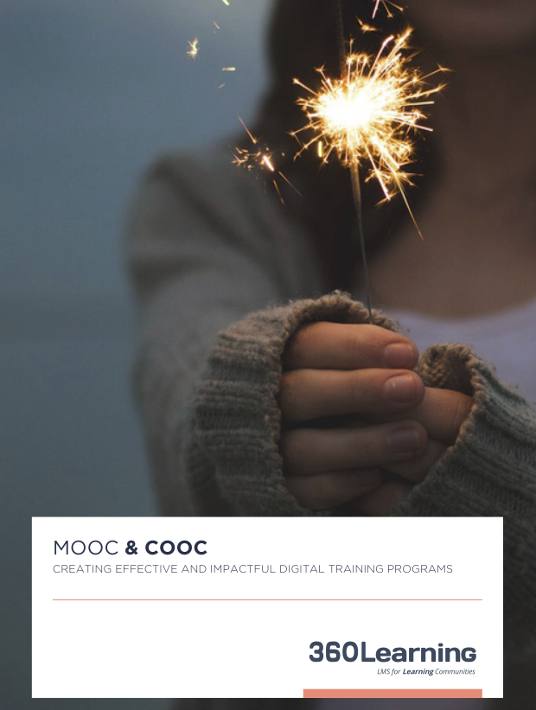COOCs: MOOCs For Business
Going over university-level MOOCs was a necessary step to move on to corporate MOOCs, also called COOCs for Corporate Open Online Courses. So, what’s a COOC? It’s simply a MOOC created, offered, produced, and distributed by a private company. There are 2 main types of corporate MOOCS, or COOCS, “external” and “internal” COOCs.

External COOCs
External COOCs are most similar to traditional university MOOCs. Anyone can sign up to follow the course, often free of cost. They also respect the same structure as university-level MOOCs with the same four characteristics:
- They leverage web formats
- They are collaborative
- They contain evaluation modules
- They are limited in time
What is different, however, is that a corporation creates them.
A Quick History
External COOCs first appeared at the beginning of 2013. Companies quickly created their own platforms, including German company SAP that created Open-SAP to distribute courses about the technology sector. The Bank of America also partnered with Khan Academy to create BetterMoneyHabits.com where they provided online courses about loans, real estate, and saving strategies.
Why Create COOCs?
Companies that create external COOCs have different objectives. One goal can, of course, be to use them as a communication tool, but they can also be used for client education, expertise certification, branding, or sourcing.
1. A Communication Tool
Today, the main goal of an external COOC is corporate communication. The idea is to simply leverage the popularity of university MOOCs. Everybody is talking about them and now is the ideal moment to create an innovative brand image by launching a COOC with a dedicated PR strategy. Businesses that used this tactic were right to do so, because, like it or not, COOCs are above all a communication tool and should be treated like one. A communication agency can be used to create quality content and highlight this content during PR campaigns. It should be noted that COOCs can also be used as internal communication tools to effectively educate employees about internal changes taking place within the business. SAP, the company cited earlier, strongly promoted their MOOCs internally.
2. Client Education And Expertise Certification
MOOCs might also have a secondary goal aimed at educating clients or certifying expertise. Companies that provide complex products will often want to train users without having to recruit a large team of consultants to do so. For example, through their external COOC, Cloudera wanted to train their clients on the Hadoop-Apache framework, an extremely advanced computer programming technology that they use. COOCs are an ideal way to evangelize technological solutions within a certain community; in Cloudera’s case, CTOs, technical directors, and the web developer community as a whole.
Client education can also be designed with a more consumer-driven strategy, as was the case with Bank of America’s BetterMoneyHabits COOCs that provided advice on loans, insurance, and other banking products. When a company produces several courses related to their products, COOCs can also be considered as an ideal support tool. This is especially true for new product releases. For example, when a software company launches a new version of their product, even a very short COOC can help avoid the client support team from being flooded with questions from clients and users.
You can even take it one step further and provide client certification via COOCs. Specifically, by certifying a skill or a set of skills related to the product, a technology or any other topic. This is more or less what Google does when an agency is “Adwords Certified”. COOCs can be used to develop similar strategies.
3. Corporate Branding
Of course, if a company claims to be an expert on a given topic or seeks to educate a large audience on the use of their products, this will have an impact on their corporate brand image. Today, COOCs help organizations improve their brand image and enhance their attractiveness to potential employees. Furthermore, the idea that a company is open-minded and that digital training is a core value will help win over the younger generation, including Generation Y that is notoriously hard to please.
4. Sourcing
Corporate MOOCs can also be used to generate and collect a large amount of data. COOC administrators can identify what content is the most popular, if questions are too hard, but above all identify the most and least engaged learners by looking at how much time they spend in the COOC – who looked at the most content, who received certification, and so on.
As part of an HR recruitment process, this is a new way of discovering talented people, especially in niche areas. If you create a COOC on a given topic, the course administrator can immediately see on their dashboard which learners received top scores. As part of a sales strategy, COOCs can be used for lead generation. That is to say, for finding people interested in your product or services.
External corporate MOOCs must be thought out and integrated into overall HR and marketing strategies. Choosing a platform and the best third-party service providers are essential for ensuring that a COOC is successful and for enhancing brand image.
Internal COOCs
Corporate Objectives
To be clear, internal corporate MOOCs have the same objectives as traditional training programs and consequently, classic eLearning methods. The goal is to continually align employee skill levels with the needs and requirements of the market in which the company operates. As a result, what are we referring to when we are talking about an internal MOOC? Are there fundamental differences between traditional eLearning platforms and corporate MOOCs? Without a doubt, the answer is yes.
It is true that corporate MOOCs and eLearning share the same objective, however they address it with a radically different philosophy and method. Whether it is the learning experience, the format used, course structure, collaboration or the trainer-learner dynamic, the learning environment and pedagogical philosophy are starkly different from traditional practices. Internal COOCs employ the same teaching methods and pedagogical modalities of external COOCs but do so in a closed environment focused on corporate goals.
Main Differences With Traditional eLearning
A corporate MOOC, rather than investing heavily in sophisticated graphics, focuses on short, punchy formats that work well online. For example, to train a group of sales representatives on a new offer, a Wikipedia-style “cheat-sheet” focused on key information will be much more effective than a 5 minute animated video with flying planes or talking carrots. Why? Because the online training interface is like any other website on the Internet: it is subject to competition. If learners need to wait 5 minutes to access the information they need to sell your products (since they are forced to watch a long video) whereas on Google, a simple click or two is enough to find the correct information, the battle is already lost. Learners must at no point feel that their time is being wasted. Internal COOCs are therefore unique in that they must respect this requirement of immediate knowledge accessibility.
Internal MOOCs move beyond the traditional eLearning pitfall of excluding the educator from the training course. There was for a long time a wall between traditional face to face classes and eLearning, with no coherence or synergy between the two. In a MOOC, the trainer is once again in a central and legitimate role, as in a traditional attended class, with technology to help recreate the classroom environment on a larger scale. Notification systems and rich profiles (with real human beings, not avatars) help continually remind users that they are participating in a collaborative course and that they are part of a community of learners.
For example, if a learner encounters a problem while taking an internal COOC, they can post their question on the forum where the teacher or other learners can provide clarification. As during an attended class, this educational content will be available to the entire community and the class as a whole will benefit from the information.
The difference, however, with a traditional attended class is that the question will be answered once by the teacher or a learner but will be available for the next 500 people who take the class. Internal COOCs allow your trainers to be more productive and to provide quality teaching at scale. Furthermore, by giving participants the possibility to like/comment/endorse course content and comments, they feel socially validated and are encouraged to participate even more. The most relevant content, validated and approved by the community, is highly visible and more accessible.
Finally, learners provide a constant flow of feedback via collaborative platform interfaces and allow training organizations to continuously, and quickly, improve their courses. This differs from the traditional eLearning system where you have to wait until the end of the course to evaluate whether or not it was inadequate or a failure (using satisfaction surveys). By then, it is already too late to take action and the learner has wasted their time. Internal COOCs make it possible to take into account course feedback, suggestions for improvement, and criticism in real-time.
eLearning:
- Over the top graphics and scenario
- Isolation: each user is alone at their workstation
- Mass standardized learning
- The trainer is excluded
- Passive learning experience
- Course improvement seen only over the long-term
Internal MOOC:
- Short formats, popular online
- "Social" validation: it’s a collective experience
- High-quality learning at scale
- Trainer at the heart of the program
- Active learning experience
- Improvement in real-time
eLearning is a cold and dehumanizing environment where the learner is alone. Conversely, with MOOCs/COOCs, learners are part of a community. eLearning is to a MOOC what a television is to YouTube.
“Open” Knowledge
It is important to keep in mind that COOC stands for Corporate Open Online Courses. With corporate MOOCs, the “O” for Open is based on the fact that there will be multiple courses, offered in “volumes” to all employees. It is a voluntary decision to take these COOCs that provide certifications. Each employee can improve in the areas and learn about the subject matters that they chose, at their own pace, and only if they want to advance professionally. This is especially true for certifications that are exportable to LinkedIn, as 360Learning allows. They help increase user employability.
Additionally, the inherent temporality of MOOCs creates different classes and employees feel like they are back in university. COOCs also provide data that can be extremely helpful to your business: which employees are the most motived? What are their career ambitions? What are they interested in? And so on.
- Driving innovation
Shared learning increases the collective intelligence of a company and promotes innovation. - Profitability
COOCs can be produced quickly at low costs and makes your educational strategy more dynamic. - Agility
Easy to produce and animate, internal COOCs help you react in real-time to your organization’s needs. - Enthusiasm
Inline with current online habits, COOCs (fast and universal) are exciting for all generations. - Quality at scale
COOCs put the trainer back at the core of the training strategy. Technology makes it possible to provide quality learning at scale. - Voluntary involvement
COOCs maximize employee engagement by making them active in the learning process and dividing courses into mini-events.
If you want to learn more about MOOCs and COOCs, download the eBook MOOC & COOC - Creating Effective And Impactful Digital Training Programs.







